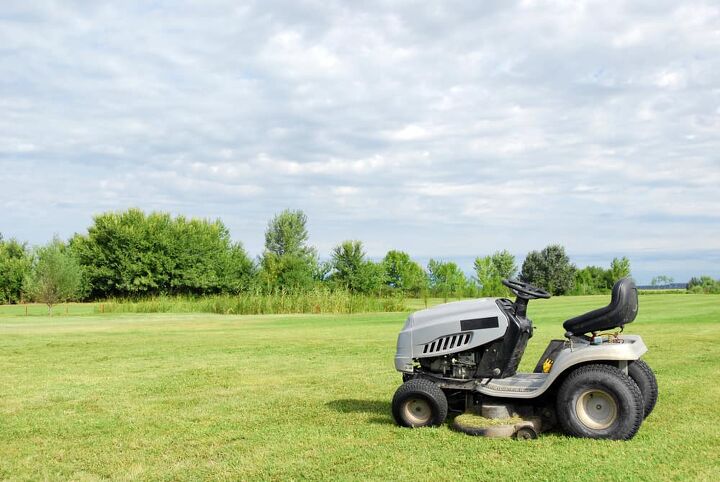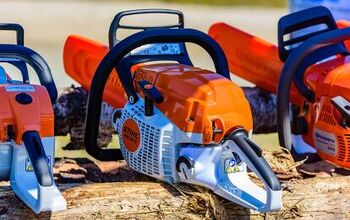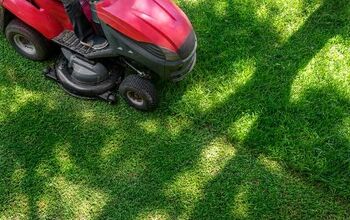Riding Lawnmower Won't Start And No Clicking? (We Have a Fix!)

Owning a riding lawnmower can make cutting the grass an easy chore. However, because the machine is relatively complex, it can sometimes break down and not start. If that does happen, you need to know how to diagnose the problem so that you can get your mower up and running again.
Your riding lawnmower won’t start and you won’t hear clicking if the battery is dead. Damaged solenoids can also prevent the riding mower from starting and you will need to replace it. Make sure that your transmission is in the correct position because that can keep the lawnmower from starting.
This article will dive deep into each of these potential issues and show you how to fix them. In most cases, you should be able to correct the problem yourself before calling a professional to come to your house.
Do You Need a Mower Repair Service?
Get free, zero-commitment quotes from pro contractors near you.

The Problem: A Dead Battery
By far, the most common reason for a riding lawnmower not to start is that the battery is either fully dead or no longer holding a charge. If you haven’t replaced the battery in years, it could be corroded to the point where it won’t provide any power to the engine. Similarly, if you left the ignition switch on, it could have drained the battery completely. Usually, if there is still a charge, you will hear clicking.
The Solution: Charge or Replace the Battery
Fortunately, this remedy is relatively easy, so you should be able to have your riding lawnmower up and running in no time. If the battery is not that old, we recommend charging it to see if that will be enough. In some cases, the unit may not hold a charge for too long, meaning that you have to jump-start it every time you want to run the mower. If that does happen, you will have to replace the whole thing.
Charging the Battery
The best option for doing this is to buy or rent a portable battery charger. You can potentially use your car to jump-start a lawnmower, but it can be risky. You can learn more about how to do that here. Most riding lawnmower batteries are 12 volts, so it should be easy to find a charger for your machine. Follow these steps:
- Step One: Lift the Mower Seat to Access the Battery – Most manufacturers place the battery under the seat. If it is not there, consult your owner’s manual.
- Step Two: Connect the Charger – Start with the red clips and then connect the black ones. Also, make sure that your charger doesn’t use more than 10 amps, or you will damage the battery.
- Step Three: Plug in the Charger – Hopefully, your lawnmower is relatively close to an outlet. However, using an extension cord is okay.
- Step Four: Wait an Hour – If your charger is running at 10 amps, it should take about an hour for a full charge. Fewer amps will take more time.
- Step Five: Disconnect the Charger – Do this in the reverse order of step two.
- Step Six: Replace the Seat and Test the Mower – If the machine still doesn’t turn on, the battery likely isn’t holding a charge, so it will have to be replaced.
Replacing the Battery
When replacing a lawnmower battery, you have to make sure that it is compatible with your specific make and model. Otherwise, the unit won’t fit. Follow these steps to replace the battery.
- Step One: Lift the Mower Seat – Again, check your owner’s manual if the battery is not there.
- Step Two: Disconnect the Negative Terminal (Black) – You always want to start with the negative terminal first so that you don’t accidentally complete a circuit when working on the positive one. A socket wrench should be all you need to do this.
- Step Three: Disconnect the Positive Terminal (Red) – Try not to touch any metal components when removing the bolt.
- Step Four: Remove the Crossbar – Many lawnmowers have a bar that holds the battery in place. Usually, these mechanisms are fastened with a hook, so you don’t need any additional tools.
- Step Five: Remove the Battery – Look for corrosion or acid on the bottom of the plate. If there is any residue, be sure to clean it off with vinegar before putting the new battery in. We also recommend wearing gloves to protect your hands.
- Step Six: Install the New Battery – Set it inside the holster and replace the crossbar (if applicable)
- Step Seven: Reconnect the Positive and Negative Terminals – Be sure to do this in the reverse of steps two and three. Still, try to avoid touching any metal when replacing the bolts.
- Step Eight: Lower the Seat and Test the Mower – Once the new battery is connected, the lawnmower should start right away. If it doesn’t, move onto the next solutions within this article.
The Problem: Incorrect Starting Procedure
Modern riding lawnmowers have multiple sensors installed to prevent the machine from starting in an unsafe position. Because there are so many, it can be easy to forget one of them when starting the machine. Unlike your car, you have to do more than just press the brake pedal when turning the ignition. If the battery is not the problem, you are likely missing a step in your starting procedure.
The Solution: Double-Check Your Starting Procedure
Although some mowers are unique, these are the primary steps to follow when trying to start the machine.
- Sit in the Seat – A weight sensor ensures a driver is sitting down before the mower can turn on.
- The Blade is Turned Off – If the blade knob is in the on position, the engine won’t engage.
- Transmission is In Park – Sometimes, you might have moved the handle by accident.
- Brake Pedal is Pressed – Don’t forget this crucial step.
- Hood is Not Open or Ajar – On some mowers, if the hood is open or unfastened, a sensor will prevent the engine from starting. Inspect the hood to ensure that it is closed all the way.
Another potential problem could be that the cutting deck is lowered. If you have done everything else correctly and the mower still isn’t turning on, try raising the deck height. If that still doesn’t work, the problem is likely the solenoid or the ignition system.
The Problem: Faulty Solenoid
Like your car, a riding lawnmower uses both a starter solenoid and a battery to start the engine. If you hear a clicking noise, the solenoid is working, but it isn’t getting enough power from the battery. If there is no clicking and the battery is not the issue, the solenoid is probably dead. In that case, you will have to replace it.
The Solution: Replace the Solenoid
This job is relatively easy to do, and all you’ll need is a socket wrench set and a pair of gloves. Here are the steps to put a new solenoid into your lawnmower.
- Step One: Lift the Seat and Access the Battery
- Step Two: Disconnect the Battery Terminals – Remember, start with the negative terminal (black) and then move to the positive one.
- Step Three: Remove the Battery – When doing this, check for corrosion or leaks at the bottom of the battery box. Clean it if necessary.
- Step Four: Disconnect the Seat Switch Wire Harness – Some models don’t have this, so you can skip this step if so.
- Step Five: Remove the Battery Box – Usually, there are clips on either side holding it in place.
- Step Six: Make a note of the Wires Connected to the Solenoid – We recommend taking a picture, so you don’t forget.
- Step Seven: Disconnect the Wires From the Solenoid – Since you don’t have to worry about completing a circuit anymore, you can remove the terminals in any order. There are two sets of wires that have to be disconnected, so it helps to have a photo reference for later.
- Step Eight: Remove the Mounting Bolt – This is usually attached at the front of the solenoid.
- Step Nine: Remove the Old Solenoid – There is often a tab you will have to pull out to release the unit. Remove the mounting tab from the old solenoid.
- Step Ten: Place the New Solenoid – Put the mounting tab on the new unit and fasten it with the bolt.
- Step Eleven: Reconnect the Wires – Use your photo to ensure that they are connected correctly.
- Step Twelve: Replace the Battery Box – Use the tabs to hold it in place and re-engage the wire harness.
- Step Thirteen: Replace the Battery and Reconnect the Terminals – Remember to do this in the opposite order, starting with the positive terminal (red).
- Step Fourteen: Lower the Seat and Test the Mower – The machine should start immediately.
Do You Need a Mower Repair Service?
Get free, zero-commitment quotes from pro contractors near you.

Related Questions
What if I do hear a clicking noise?
In almost all cases, that means that the battery is drained. Recharge it, and the mower should start with no further interruptions.
What if my mower starts and then dies immediately?
In that instance, there can be multiple problems, from a dirty carburetor to a faulty spark plug. You will have to inspect these components to see if they are causing the issue.

We are a team of passionate homeowners, home improvement pros, and DIY enthusiasts who enjoy sharing home improvement, housekeeping, decorating, and more with other homeowners! Whether you're looking for a step-by-step guide on fixing an appliance or the cost of installing a fence, we've here to help.
More by Upgraded Home Team



























